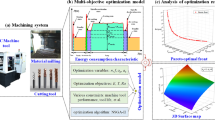Abstract
This paper reports on the development of a module to calculate automatically tool paths and cutting conditions for metal cutting operations. Process planning must select correct cutting conditions to minimise disturbances on the shop floor owing to tooling problems. Tool path and cutting condition algorithms to generate reliable NC programs have been designed. The algorithms have been implemented in the framework of a generative computer-aided process planning system, called PART. Geometrical requirements to avoid chipping of cutting teeth are considered in tool-path calculation. The cutting conditions are calculated using metal cutting process models. A method has been developed to calculate cutting forces for milling operations based on experimental data of cutting forces in turning. In the process models, various constraints of the machine tool, cutting tool, and the workpiece are considered.
Similar content being viewed by others
References
F. J. A. M. van Houten, “PART a computer aided process planning system”, Ph D thesis, University of Twente, NL, 1991.
H. A. ElMaraghy, “Evolution and future perspectives of CAPP”,Annals of the CIRP,42(2), pp. 739–751, 1993.
I. Ham and S. C. Y. Lu, “Computer aided process planning: the present and the future”,Annals of the CIRP,37(2), pp. 591–601, 1988.
L. J. Dammer, “Ein Beitrag zur Prozessanalyse and Schnittwert-vorgabe beim Messerkopf-stirnfräsen”, (i.e. Process analysis and cutting condition generation for face milling), PhD thesis, University of Aachen (RWT), D, 1982.
Machining Data Handbook, Metcut Research Associates Inc., Cincinnati, Ohio, 1966.
W. König, “Zerspanwerte für die Fertigung aus der INFOS-Datenbank”, (i.e. Cutting data for manufacturing from the INFOS database),wt-Z, ind. Fertig,69(1), pp. 58–59, 1979.
L. J. Dammer, M. Hoff and H. Wesch, “Bereitstellung optimierter Zerspandaten durch technologisch orientierte Datenbanken” (i.e. Generation of optimised cutting data with technology oriented databases),VDI-Z 123(20), pp. 827–832, 1981.
F. J. A. M. van Houten and J. J. Tiemersma, “An adaptive control module for ROUND”,Proceedings 19th CIRP International Seminar on Manufacturing Systems, Pennsylvania State, USA, 1987.
M. Kronenberg,Machining Science and Application, Pergamon Press, Oxford, 1966.
M. C. Shaw,Metal Cutting Principles (Oxford series on advanced manufacturing; 1 metal-cutting). Clarendon Press, Oxford, 1984.
B. Colding, “Relative effects of shop variables on manufacturing cost and performance”,Annals of the CIRP,27(1), pp. 453–458, 1978.
O. Kienzle, “Determination of forces and power for cutting tools and machine tools” (in German: Bestimmung von Kräften und Leistungen an spanenden Werkzeugen und Werkzeugmaschinen),Z. Verein Deutsche Ingenieure 94, pp. 299–305, 1952.
L. Witte, “Spezifische Zerspankräfte beim Drehen und Bohren” (i.e. Specific cutting forces in turning and drilling), PhD thesis, University of Aachen, D, 1980.
T. L. Lau, “Optimization of milling conditions”, PhD thesis, University of Manchester, UK, 1987.
W. König, K. Essel and L. Witte, “Specific Cutting Force Data for Metal-Cutting”, Verlag Stahleisen m.b.H., Düsseldorf, D, 1982.
R. Wertheim and A. Satran, “New cutting tool geometries for shank-, face and corner mills”,Proceedings CIRP/VDI Seminar: Developments in Cutting Technology, pp. 85–101, Düsseldorf, September 1993.
W. A. Kline, R. E. DeVor and R. Lindberg, “The prediction of cutting forces in end milling with application to cornering cuts”,International Journal of Machine Tool Design and Research,22, pp. 7–22, 1982.
K. D. Bouzakis and G.Methenitis, “Determination of the values of the technolgical parameters which are used to describe the time course of cutting force components in milling”,Annals of the CIRP,34(1), 1985.
J. R. Boerma “The design of fixtures for prismatic parts”, PhD thesis, University of Twente, NL, 1990.
F. J. C. M. Jonkers, “A software architecture for CAPP systems” PhD thesis, University of Twente, NL, 1992.
A. Lenderink, “The integration of process and production planning in small batch part manufacturing”, PhD thesis, University of Twente, NL, 1994.
R. M. Boogert, “Tool management in computer aided process planning”, PhD thesis, University of Twente, NL, 1994.
M. Held,On the Computational Geometry of Pocket Machining, Springer Verlag, 1991.
Kistler,Operating instructions Three Component Dynamometer type Z 11206 SN 108482. Winterthur, Switzerland, 1978.
Author information
Authors and Affiliations
Rights and permissions
About this article
Cite this article
Boogert, R.M., Kals, H.J.J. & van Houten, F.J.A.M. Tool paths and cutting technology in computer-aided process planning. Int J Adv Manuf Technol 11, 186–197 (1996). https://doi.org/10.1007/BF01351324
Issue Date:
DOI: https://doi.org/10.1007/BF01351324




